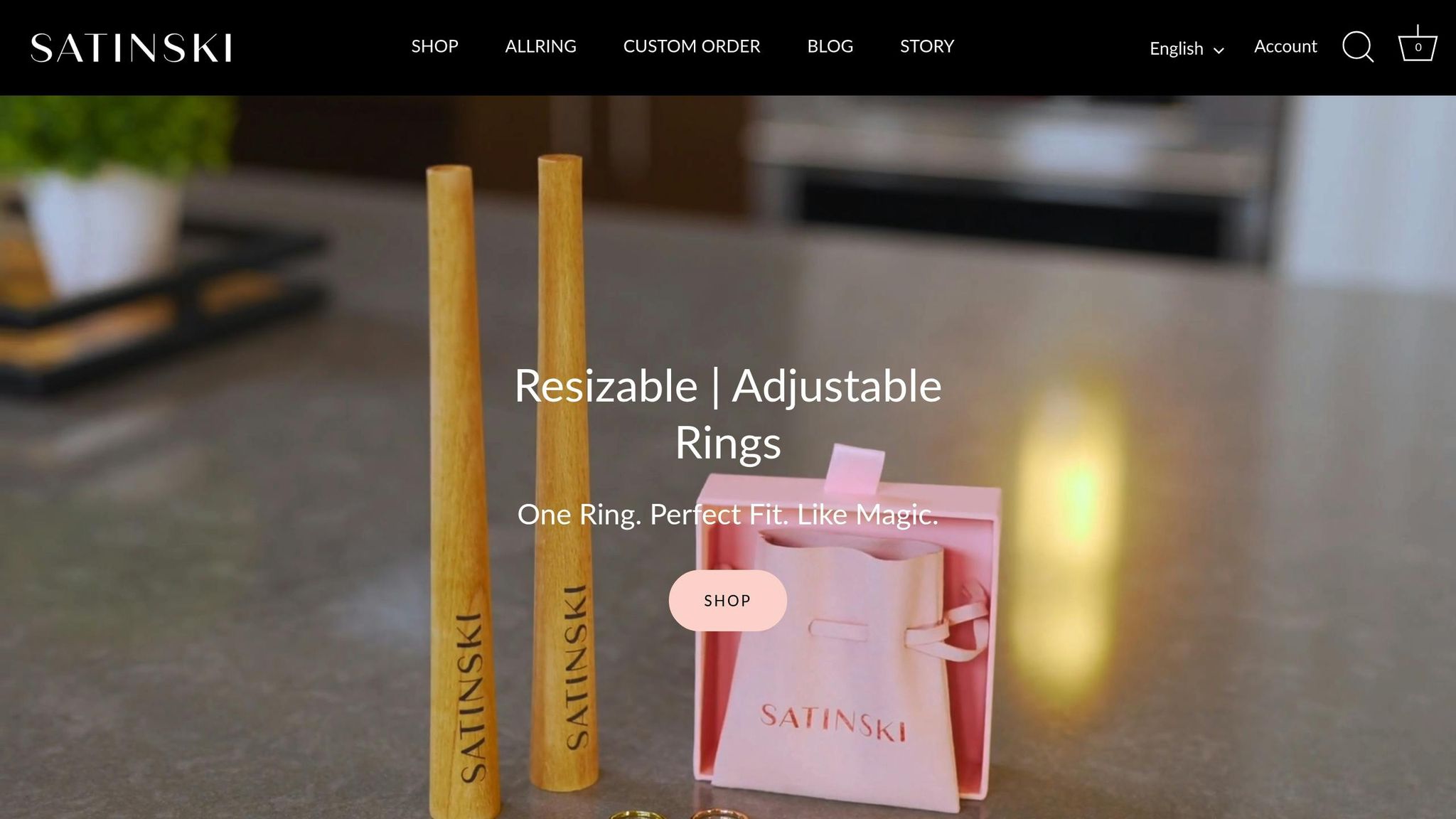
指輪のサイズチェックリスト:毎回完璧なサイズ
快適さ、安全性、そして高額なサイズ直しを避けるために、適切にフィットしたリングが不可欠です。きつすぎるリングは不快感を引き起こし、緩すぎるリングは落下のリスクがあります。リングサイズを正確に測定し、完璧なフィット感を確保する方法は次のとおりです:
- プロ用ツールを使用する:プラスチック、金属、またはデジタルのリングサイザーは正確な結果を提供します。
- DIY方法:ツールがない場合は、紙や紐で周囲を測ることができます。
- 印刷可能なサイズチャート:既存のリングや指をチャートの円と合わせて素早くサイズを測定します。
- モバイルアプリ:便利ですが信頼性はやや低く、初期の推定に最適です。
- タイミングが重要です:指が最も大きくなる午後に測定してください。
- バンド幅を考慮する:幅の広いバンドは少し大きめのサイズが必要な場合があります。
- ライフスタイルの変化を考慮する:季節の変化、体重の変動、健康状態がフィット感に影響を与えることがあります。
柔軟性を求めるなら、Satinskiのような調節可能なリングが実用的な解決策を提供し、複数のサイズにフィットしながら洗練されたデザインを維持します。常に測定を二重に確認し、関節のサイズや温度などの要因も考慮して最良の結果を得てください。
リングサイズの正しい測り方! | 最悪から最高までの6つの方法。
正確なリング測定に必要なツール
自宅でリングサイズを測るのは思ったより簡単です。適切なツールと技術を使えば、ジュエリー店に行かなくても自信を持ってサイズを決められます。
プロフェッショナルリングサイザー
プロフェッショナルリングサイザーは正確な測定のための定番の選択肢です。これらのツールはプラスチック、金属、またはデジタルのさまざまな形態で提供され、正確なフィット感を得るために設計されています。
- プラスチック製リングサイザー:手頃で使いやすく、通常5ドルから15ドルの価格帯です。標準的な米国サイズの番号付き目盛りが特徴です。
- 金属製リングサイザー:実際のリングの感触を模したより耐久性のあるオプションです。通常、15ドルから30ドルの範囲です。
- デジタルリングサイザー:これらのハイテク機器は、しばしばクォーターサイズ単位までの正確な測定を提供します。複数の測定値を記憶するメモリ機能が付いているものもあります。
これらのツールはオンライン、クラフトストア、またはジュエリー用品店で見つけることができます。多くは詳細な説明書や国際サイズ変換チャートが付属しており、国際的なサイズシステムの理解を助けます。
印刷可能なリングサイズチャート
印刷可能なチャートは、リングサイズを素早く簡単に見つける方法です。これらのチャートにはさまざまなサイズを表す円があり、既存のリングと比較したり、指のフィット感を試したりできます。
正確な結果を得るために、必ずチャートを100%のスケールで印刷してください。「ページに合わせる」やその他の拡大縮小オプションは使用しないでください。これらは測定を歪める可能性があります。開始前にチャート上の定規やテスト用の正方形を確認して、正しいスケーリングを確認してください。
チャートの使い方:
- ぴったり合うリングを円の上に置いて、最も近いサイズを見つけてください。
- リングをお持ちでない場合は、指を円の中に通して最も快適なサイズを確認してください。
多くのジュエリーウェブサイトでは、米国および国際的なサイズシステムの両方を含む無料のダウンロード可能なチャートを提供しています。
DIY方法:紙と紐
実際に手を動かす方法が好みなら、紙と紐の方法が優れた選択肢です。これらの技術は基本的な家庭用品だけで行えます。
- 紙の帯の方法:長さ約6インチ、幅約½インチの紙の帯を切り取ります。指輪がはまる指の根元に巻き、重なった部分に印をつけ、定規で長さを測ります。このミリメートル単位の測定値が指の周囲長に対応します。
- 紐の方法:伸縮しない紐を使って同じように指に巻きます。紐は指の形により密着するため、やや正確な結果が得られることがあります。
周囲長の測定値が得られたら、それを3.14(π)で割って直径を計算します。これを指輪サイズチャートと比較してください。チャートには通常、周囲長と直径の両方の測定値が含まれており、参照しやすくなっています。
指輪サイズ測定用モバイルアプリ
技術に詳しい方には、モバイルアプリが迅速な指輪サイズの推定を提供できます。これらのアプリはスマートフォンのカメラや画面を使って指輪サイズを測定しますが、最終決定よりも予備的な測定に適しています。
- カメラベースのアプリ:これらは指輪とクレジットカードやコインなどの基準物体を一緒に撮影する必要があります。アプリは基準物体の既知の寸法に基づいてサイズを計算します。照明やカメラの角度が精度に影響するため、複数の写真を撮ることをお勧めします。
- 画面ベースのアプリ:これらは指輪サイズの円を直接スマートフォンの画面に表示します。指輪を円の上に置くか、指を円に合わせて試すことができます。これらのアプリは異なる画面サイズや解像度に対応するよう設計されています。
モバイルアプリは便利ですが、必ずしも正確とは限りません。出発点として使用し、特に婚約指輪やカスタムジュエリーなど重要な購入の場合は、物理的な方法でサイズを確認してください。
複数の方法を組み合わせることで、より正確な結果を得ることができます。
自宅での指輪サイズの測り方
自宅で指輪のサイズを測るのは簡単そうに見えますが、正確に行うには適切なタイミング、技術、そして少しの忍耐が必要です。これらの手順に従うことで、最も正確な結果を得ることができます。
測定に最適な時間と温度
指のサイズは一日の中で変化することをご存知ですか?温度、活動レベル、水分補給、さらには食事などの要因が指のむくみや縮みを引き起こします。だからこそ、指輪の測定ではタイミングが非常に重要です。
測定に最適な時間は、指が自然に最も大きくなる午後遅くから夕方早くの時間帯です。朝の指が最も小さい時に測定すると、後で指輪がきつく感じることがあります。また、運動直後や熱いシャワーの後、極端な温度にさらされた直後の測定は避けてください。最も正確なフィット感を得るには、手が安定した中立の温度であることが重要です。
関節と根元のサイズのバランス調整
リングサイズを見つける際の最も難しい部分の一つは、関節のサイズと指の根元のサイズの違いを考慮することです。ほとんどの人にとって、関節は少し大きいため、リングは関節を快適に通過しつつ、根元でしっかりフィットする必要があります。
これに対処するには、指の根元と関節を別々に測定します。そして、その2つの測定値の間のサイズを選びます。例えば、指の根元がサイズ6で関節がサイズ7の場合、サイズ6.5が最適な選択肢となるでしょう。こうすることで、リングは関節を通過しやすく、日常の着用中も安定してフィットします。適切なフィット感はきつすぎず、指に跡がつかずにリングが自由に回転することが理想です。
測定の再確認
一度測定したらそこで終わらず、再確認が正確さの鍵です。数回繰り返すことで、一貫した結果が得られているか確認できます。
指のサイズは数日にわたって3〜4回測定してください。さらに正確にするために、複数の方法を試すのもおすすめです。例えば、最初に糸を使った方法で測った場合は、印刷可能なサイズチャートやリングサイズゲージツールと比較してみてください。このように結果を照合することで、正確なサイズを確認できます。
測定値が2つの標準サイズの間にある場合は、通常は小さくするより大きくする方が良いです。少し大きめのリングはジュエラーによるサイズ直しが可能なことが多いですが、小さすぎるリングは不快で着用できないこともあります。さらに、多くのリングスタイルでは4分の1サイズも用意されているので、サイズの間にある場合はそれらのオプションも検討してください。
リングサイズに影響を与えるもの
リングサイズは思っているほど固定的ではなく、さまざまな要因で変動します。これらの変化は日々、季節ごと、または年を経て起こることがあります。
温度と活動による変化
温度はリングのフィット感に大きく影響します。寒い時期は指が縮みやすく、暑い時期はむくみやすくなります。運動、塩分の多い食事、アルコール摂取、ストレスなども一時的に指をむくませることがあります。したがって、リングサイズを測る際は、指が「通常の」サイズの時に測ることが重要です。
リングバンドの幅とフィット感
リングバンドの幅は、着け心地に大きな違いをもたらします。幅の広いバンドは自然と指のスペースを多く占めるため、同じサイズの細いバンドよりもきつく感じることがあります。
"リングが幅広であるほど、フィットさせるためには大きめのサイズが必要です。" - Ash Hilton Jewellery
4mmより幅の広いSatinskiバンドを選ぶ場合は、サイズを4分の1から1サイズ大きくする必要があるかもしれません。一方で、丸みを帯びたコンフォートフィットのバンドは、少し小さめのサイズが必要な場合があります。最適なフィット感を得るには、購入予定のリングの幅に合ったサイズゲージを使用してください。
ライフスタイルと季節の変化
ライフスタイルや季節もリングサイズの変化を引き起こします。体重の増減や妊娠・更年期などのホルモン変化はリングのフィット感に影響します。10〜15ポンドの小さな体重変化でも目に見える違いが出ることがあります。
加齢も要因の一つです。時間の経過とともに、骨の厚み増加や皮膚の弾力低下により指の形が変わり、関節が広くなることがあります。20代でぴったりだったリングも年齢とともにサイズ直しが必要になるかもしれません。
これらの自然な変動を考慮するために、カスタムサイザーを数日間着用するのが良いでしょう。これにより、指が最大の時にぴったりで、最小の時に外れないサイズを見つけることができます。
注意すべき医療条件
特定の健康状態はリングのサイズ選びを複雑にします。例えば関節炎はむくみや指の形状変化を引き起こし、標準的なサイズが信頼できなくなります。同様に、骨折、捻挫、切り傷などの怪我は治癒後もリングサイズを永久に変えることがあります。
循環に影響を与えたり水分貯留を引き起こしたりする薬は、指のサイズにも影響を及ぼすことがあります。頻繁にむくみがある方には、調整可能なリングが優れた選択肢です。これらのリングは頻繁なサイズ直しを必要とせず変化に対応でき、快適さと実用性を保証します。これらの要因を理解することで、サイズが変わってもフィットするリングを選ぶ手助けになります。
sbb-itb-9da40c1
Satinskiの調整可能なリングを選ぶ理由

調整可能なリングはサイズの問題に対する賢い解決策であり、柔軟性と利便性を提供します。Satinskiのデザインはサイズの問題に対応するだけでなく、完璧で快適なフィット感を実現するための重要な特徴にも合致しています。
一つのリングで複数サイズに対応
Satinskiの調整可能なリングは米国サイズ5〜9に対応しており、ギフトに最適です。正確なサイズを気にする必要がなく、贈り物を選ぶ際の大きな安心材料となります。さらに、その多用途性により、パートナー間で共有したり世代を超えて受け継いだりしてもサイズの心配がありません。
高品質な素材と一日中の快適さ
スターリングシルバーと18Kゴールドで作られたSatinskiのリングは、耐久性と贅沢な感触を兼ね備えています。調整機構は目立たないように隠されており、リングのエレガンスを損ないません。
快適さも重要です。衣服に引っかかったり肌を刺激したりする調整可能なリングとは異なり、Satinskiの滑らかな調整機構はそうした問題を避けるよう設計されています。高品質な素材のおかげで、これらのリングは頻繁な調整にも形状や仕上げを保ち、購入した日の美しさを維持します。
変わる指のサイズに最適
これらのリングの際立った利点の一つは、自然な指のサイズ変化に適応できることです。暑い日にはリングを緩め、寒い時には締めるなど、簡単に調整してしっかりとしたフィット感を得られます。
関節炎や定期的なむくみに悩む方にとって、これらのリングは画期的です。複数のサイズを用意したり、サイズ直しのために何度も宝石店に行く必要がなくなります。妊娠、体重の変動、季節の変化にかかわらず、これらのリングはあなたのニーズに合わせて調整でき、実用性と快適さを提供します。
カスタムデザインオプション
Satinskiはリングを本当にパーソナルなものにする機会も提供します。彼らのカスタムオーダーでは、複雑な葉の模様、時代を超えた無限のデザイン、または輝くモアッサナイトのセッティングなど、さまざまなスタイルから選べます。完全にユニークなものが欲しいですか?彼らのチームがあなたと協力して、完全にあなただけのデザインを作り上げます。
さらに特別な意味を加えるために、刻印オプションも利用可能です。特別な日付、意味のあるテキスト、またはシンボルを入れて、実用的でありながら個人的なリングにできます。婚約指輪、結婚指輪、記念品のいずれであっても、Satinskiのカスタムデザインは美しさと機能性をシームレスに組み合わせることができます。
調整可能な実用性とパーソナライズされたエレガンスを兼ね備えたこれらのリングは、日常使いから人生の最も記念すべきお祝いまで、あらゆる場面に最適です。
避けるべき一般的なリングサイズのミス
完璧なリングのフィット感は一度の測定だけでは得られません。正しい測定方法を使っても、不快なフィット感につながる一般的なミスがあります。注意すべきポイントは以下の通りです:
間違った時間に測定すること
指のサイズは一日の中で変わることをご存知ですか?間違った時間に測ると結果が狂うことがあります。例えば、指は通常朝は小さく、運動後は血流の増加でむくむことがあります。
最も正確な測定のためには、午後の中頃から遅い時間を目指してください。塩分の多い食事の後は一時的なむくみが生じるため測定を避け、手が非常に冷たい時も避けましょう。冷えた指は最大で半サイズ縮むことがあります。冬なら測定前に手を室温に温めてください。夏は快適な空調の効いた環境が最適です。
一つの測定方法だけを使うこと
一つの方法に頼るのはリスクがあります。もし糸で測ってサイズ7が出たら、印刷可能なリングサイザーや他のDIYツールで再確認してください。2つか3つの方法で一貫した結果が得られれば、自信を持てます。測定結果が異なる場合は、最も頻繁に出るサイズを選ぶか、不快感を避けるために大きい方を選びましょう。
バンド幅を考慮しないこと
リングバンドの幅は指に感じるフィット感に大きく影響します。同じサイズでも6mmのバンドは2mmのバンドよりも表面積が広く柔軟性が低いため、よりきつく感じます。
ジュエリーの専門家は、6mmを超えるリングを「幅広バンド」と分類することが多いです。これらは通常、サイズを4分の1から半サイズ上げる必要があります。幅広のバンドは関節を通る際に抵抗が大きくなり、細いリングよりもきつく感じることがあります。細いバンドに慣れていて8mm以上の幅広バンドに変える場合、いわゆる「正しい」サイズでも明らかに異なるフィット感を期待してください。
日々および季節の変化を無視すること
指のサイズは一定ではなく、日々や季節によって変動し、時には半サイズも変わることがあります。一度だけ測ってそのサイズが一年中合うと仮定すると、特に指がむくんだり縮んだりする場合に問題が生じる可能性があります。
定期的にサイズが変わる場合は、調節可能なリングが最適かもしれません。これにより柔軟性が得られ、指のサイズが日中や一年を通じて変わっても快適さが保証されます。
毎回正しいリングサイズを得る方法
完璧なリングのフィット感を確保するには、一度測ってうまくいくことを願うだけではありません。サイズの微妙な違いやライフスタイル、リングのデザインなどの要素を理解することが重要です。
正確な測定から始めましょう。最良の結果を得るために、プロのリングサイザーを使うか、印刷可能なサイズチャートとDIYの方法を組み合わせて数値を二重に確認してください。指のサイズが最も安定する午後の中頃から遅い時間に測定し、異なる方法で複数回測定を行いましょう。この方法が快適にフィットするリングの基礎を築きます。
バンド幅と指の変化を見落とさないでください。幅広のバンド(6mm以上)はきつく感じやすいため、これらのスタイルでは通常、サイズを4分の1から半サイズ上げるのが賢明です。指のサイズは一定ではなく、運動や手作業、季節の温度変化などの要因で変動することを覚えておいてください。これらの変化は一年を通じてリングの着け心地に影響を与えます。
調節可能なリングは大きな変化をもたらすことがあります。Satinskiのような調節機能付きのリングは、サイズの問題に対する実用的な解決策を提供します。サイズ範囲は5から9で、スターリングシルバーや18Kゴールドなどの素材で作られており、優雅な外観を損なうことなく日常的に調整できる隠れたメカニズムが含まれています。むくみや体重の変化、その他のサイズ変動に対応するのに理想的で、快適さと柔軟性を兼ね備えています。
重要なポイントは?正確な測定と指のサイズやリングのデザインがどのように関係するかを理解することを組み合わせることです。この慎重なアプローチにより、どんな場面や季節でもジュエリーがぴったり合い、快適に感じられます。
よくある質問
体重や健康状態の変化で指のサイズが変わった場合、リングを快適に着け続けるにはどうすればいいですか?
指のサイズは固定されているわけではなく、体重の変化や特定の健康状態などによって時間とともに変わることがあります。リングを快適に保つために、いくつかのヒントをご紹介します:
- 定期的にサイズを確認する:指のサイズは、温度、活動量、さらには水分補給によって一日の中でも変動します。最も正確なフィット感を得るために、異なる時間帯で測定しましょう。
- 調整可能なリングを選ぶ:サイズの微妙な変動がある場合は、調整可能なリングが便利です。サイズ直しの手間なく適応します。
- ジュエラーに相談する:サイズの変化が大きい場合は、プロのジュエラーにリングのサイズ直しを依頼して、再び完璧にフィットさせましょう。
活動的に過ごし、バランスの取れた生活を維持することも、指のむくみや体液の貯留を最小限に抑えるのに役立ちます。これらの変化に注意を払うことで、リングは常にちょうど良いフィット感を保てます。
リングサイズを測る際のモバイルアプリの利点と欠点は、伝統的な方法と比べて何ですか?
リングサイズを測るモバイルアプリは、自宅の快適な環境で素早く測定できる便利な方法です。スマートフォンと最小限の道具だけで、すぐにサイズを推定できます。これらのアプリは使いやすく、迅速な解決策を求める人に最適です。ただし、使用方法やデバイスのカメラの品質、温度やむくみによる指の自然なサイズ変動などの要因で、精度が影響を受けることがあります。
一方で、物理的なリングサイザーを使ったり、紐や定規で測るといった伝統的な方法は、より信頼性の高い結果をもたらす傾向があります。プロが行う場合、これらの方法は特に信頼できます。ただし、特定の道具や対面での訪問が必要なため、必ずしも便利とは言えません。最も正確な測定が重要なら、伝統的な方法を選ぶのが賢明です。
リングバンドの幅はサイズにどのように影響し、幅広のリングを選ぶ際に何を考慮すべきですか?
リングバンドの幅は、指に感じるフィット感に大きく影響します。幅の広いバンドは指の表面積を多く覆うため、よりきつく感じることが多いです。適切なサイズを得るためには、バンドの幅や指の形状に応じて1/4から1/2サイズ大きめにする必要があるかもしれません。
幅の広いバンドは、細いものに比べて着脱が難しいことがあります。だからこそ、サイズを正確に測ることが非常に重要です。時間をかけて慎重に測るか、できればプロのジュエラーに相談して、最適なフィット感と最大の快適さを確保しましょう。

